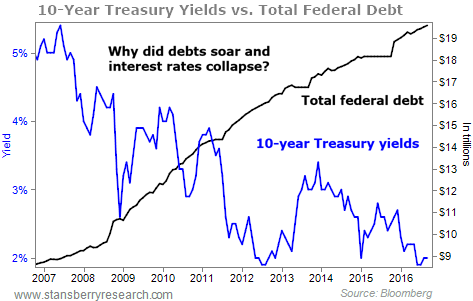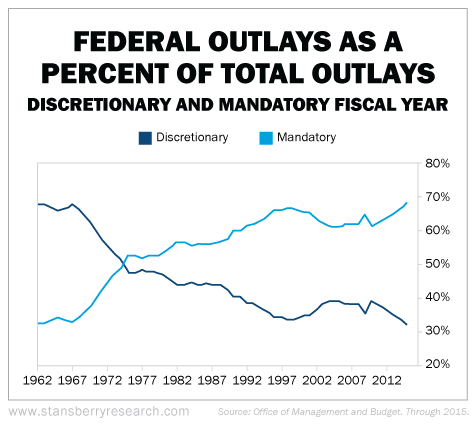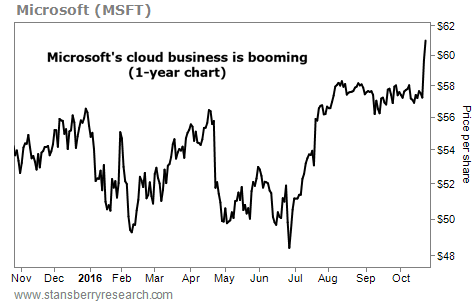| Home | About Us | Resources | Archive | Free Reports | Market Window |
The U.S. Government Is Digging Our Financial GraveBy
Wednesday, October 26, 2016
Today, we're taking on a big economic mystery...
Doesn't sound exciting, does it? Well, what you're going to learn below will be responsible for earning some investors trillions in profit over the next five years.
Investors who don't understand this concept are going to get wiped out. What's the concept? It's the answer to the following questions...
Given a 100%-plus increase in federal debt and federal debt securities over the past few years... why haven't bond prices fallen, and why haven't interest rates risen? Where is all of the inflation that should have occurred?
As you know, bond prices not only didn't fall, they have continued to hit new all-time highs, sending rates to new all-time lows. In many places, bond prices rose so much that interest rates went negative, something most people thought was simply impossible.
 Of course, federal debt levels aren't the only thing that has exploded... Let's not forget student debt, auto lending, U.S. corporations, and, perhaps the biggest debt bubble of all, foreign corporations.
In the U.S., corporate obligations are at all-time highs, relative to GDP (a little more than 45%). But in China, they're even crazier: Corporate obligations have soared in the past eight years from virtually nothing to more than 120% of GDP. The corporate debt and real estate bubble in China is probably the largest the world has even seen. (Imagine working out that problem in a nation without the rule of law or a tradition of recognizing property rights.)
In total, the International Monetary Fund says that global debt is now equal to 225% of global GDP, up from about 200% just a decade ago.
Just about every economist in the world would have told you that massive increases to credit and money supply – and the resulting huge expansion of consumption – should have set off massive inflation... or at the very least, much, much higher interest rates.
So... why didn't it happen?
It's the most important economic mystery of our lives. And the answer is finally coming into sharp view, thanks to a lot of new, fascinating economic research from major economists... all of which is teaching us something most of us would have simply called common sense: Socialism doesn't work.
The problem revolves around a simple idea that economists call a "multiplier"...
They're referring to the effect new capital has when injected into an economy. Ever since the 1920s and the days of John Maynard Keynes, economists everywhere have assumed that government borrowing and spending would produce a positive multiplier for the economy. They've thought of the government's spending as "priming the pump."
For example, if the government borrows money to build new roads, then private industry would be spurred to build new houses along the roads and build new businesses to serve those houses, etc.
That's the theory. But does it actually happen in practice? That's where a whole slew of new research comes in.
As it turns out, there is a multiplier effect associated with government spending. But based on empirical studies, it's actually negative. That is, rather than spurring growth, more government borrowing and spending is strongly correlated with less economic growth.
Part of this is because governments are generally really bad investors...
Much of the capital they borrow and invest is wasted. And as debt-to-GDP levels surpass around 80% of GDP, the real problems begin. Research suggests that when debt-to-GDP levels stay above 90% for more than five years, the resulting damage to economic growth is particularly severe.
Worst of all, changes to the multiplier of government spending are non-linear. The multiplier doesn't just get a little bit worse as debts and spending increases... It falls of a cliff as debts mount. Or, in plain English, the more money governments borrow and spend, the worse the impact is on economic growth and wealth creation.
The data show that the U.S. economy is likely to experience big declines in GDP growth as our government continues to borrow and spend more and more in an effort to reverse the declining economy.
That will hurt overall productivity, corporate profits, industrial production, employment, and consumer spending – all with increasing severity as the magnitude and duration of the debt is extended. We've already seen these troubling data points occur over the past 24 months. Government borrowing and spending are literally digging our financial graves.
And the harder they dig, the worse it's going to get...
As for interest rates, the factors I've described should be more than enough to keep interest rates low. But it gets worse...
Quantitative easing (when the government prints money to buy bonds and manipulate interest rates lower) is magnifying the impact of this financial repression. And according to these studies, that's going to have an unintended consequence: much lower consumer spending.
Think about this for a minute. The government has basically sold $10 trillion in debt over the last few years.
If that debt was trading freely in the market – and hadn't been bought by central banks around the world – what would the interest rate be?
Economic theory and more than a hundred years of data tell us that interest rates should be roughly equal to annual GDP growth plus a nominal return above the inflation rate.
If growth is 2.5% and inflation is 2%, you should see short-term government bonds trading around 4.5%, with longer-dated bonds trading a little higher, say 6%.
Now, think about how much income would be generated by all of that new debt. Just looking at the recent debt (6% of $10 trillion), you would see an extra $600 billion a year sent into private hands. Looking at the total federal debt ($20 trillion), that's $1.2 trillion a year of capital sent into private hands – if the public owned these bonds and bills, and if interest rates were allowed to rise.
That's a significant amount of income for the private sector. But what happens when interest rates are manipulated to nothing and most of the debt is held by central banks or government "trust" funds?
That's taking capital away from private hands (consumption and investment) and putting it into government programs (waste, malinvestment, and disincentives to gainful employment).
Just think about what the government spends money on. Our government (and all the other major western democracies) has embraced the kind of social-spending programs that bankrupt every nation that adopts them.
 The chart above shows "mandatory spending" (aka government transfer payments) versus discretionary spending, which is everything else. Our government is no longer building bridges and enforcing contracts. It's simply taking money from Peter to pay Paul. And as you'd expect, that kind of economic activity (aka stealing) has a negative multiplier. Taking lots and lots of capital from productive hands and giving it to unproductive hands might meet political goals, but it's not good for the economy. Ready for this shocking conclusion? Socialism doesn't work. And manipulating interest rates makes it a lot worse.
Tomorrow, I'll tell you why we're about to see the biggest economic storm of our lives... and explain how you can protect yourself from it.
Regards,
Porter Stansberry
Further Reading:
Last November, Porter put together a three-part series explaining why we're quickly approaching the largest debt default in U.S. history... and what it means for investors. Catch up on that series here...
Market NotesTHIS TECH GIANT IS GROWING IN THE CLOUD Today's chart puts the spotlight on one of the world's safest long-term investments...
Longtime readers know we're fans of the tech industry. Specifically, we like "Big Cheap Tech" stocks. These firms have been around for decades and have established businesses that generate steady sales and thick profit margins. But since they rarely make headlines, investors often pass over them in favor of more "exciting" opportunities.
One of these "boring" tech companies is software icon Microsoft (MSFT). Since appointing Satya Nadella as CEO in 2014, the company has focused on driving its cloud business. That work is starting to pay off...
Microsoft calls its cloud-services division "Azure." It offers more than 600 services, from data backup to app-development technologies. Last week, Microsoft's earnings handily beat analysts' estimates. Azure revenue grew 116%, with data usage also doubling since this time last year. Its shares are now trading at a new all-time high. Add it to the list of reliable blue-chip businesses that continue to march higher...
 |
Recent Articles
|



